This is an old revision of this page, as edited by FreeatlastChitchat (talk | contribs) at 04:21, 27 August 2015 (clean up, typo(s) fixed: present day → present-day, Nevertheless → Nevertheless, using AWB). The present address (URL) is a permanent link to this revision, which may differ significantly from the current revision.
Revision as of 04:21, 27 August 2015 by FreeatlastChitchat (talk | contribs) (clean up, typo(s) fixed: present day → present-day, Nevertheless → Nevertheless, using AWB)(diff) ← Previous revision | Latest revision (diff) | Newer revision → (diff) "Masjid" redirects here. For the villages in Iran, see Masjed, Iran.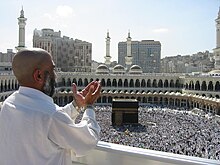
A mosque (/mɒsk/; Template:Lang-ar and Template:Lang-fa masjid, plural مساجد masājid) is a place of worship for followers of Islam.
There are strict and detailed requirements in Sunni fiqh for a place of worship to be considered a mosque, with places that do not meet these requirements regarded as musallas. There are stringent restrictions on the uses of the area formally demarcated as the mosque (which is often a small portion of the larger complex), and, in the Islamic Sharia law, after an area is formally designated as a mosque, it remains so until the Last Day.
Many mosques have elaborate domes, minarets, and prayer halls, in varying styles of architecture. Mosques originated on the Arabian Peninsula, but are now found in all inhabited continents. The mosque serves as a place where Muslims can come together for salat (صلاة ṣalāt, meaning "prayer") as well as a center for information, education, and dispute settlement. The imam leads the congregation in prayer.
Etymology

The word entered English from a French word which probably derived from Italian moschea, a variant of Italian moscheta, from either Middle Armenian մզկիթ (mzkit‘) or Medieval Greek μασγίδιον (masgídion) or Spanish mezquita, from the Arabic مسجد masjid meaning "place of worship" or "prostration in prayer", either from Nabataean masgdhā́ or from Arabic سجد sajada meaning "to bow down in prayer", probably ultimately from Aramaic sghēdh.
History
The first mosque in the world is often considered to be the area around the Kaaba in Mecca now known as the Masjid al-Haram. Since as early as 638 AD, the Masjid al-Haram has been expanded on several occasions to accommodate the increasing number of Muslims who either live in the area or make the annual pilgrimage known as hajj to the city. Others regard the first mosque in history to be the Quba Mosque in present-day Medina since it was the first structure built by Muhammad upon his emigration from Mecca in 622.
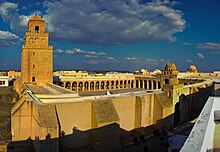
The Islamic Prophet Muhammad went on to establish another mosque in Medina, which is now known as the Masjid an-Nabawi, or the Prophet's Mosque. Built on the site of his home, Muhammad participated in the construction of the mosque himself and helped pioneer the concept of the mosque as the focal point of the Islamic city. The Masjid al-Nabawi introduced some of the features still common in today's mosques, including the niche at the front of the prayer space known as the mihrab and the tiered pulpit called the minbar. The Masjid al-Nabawi was also constructed with a large courtyard, a motif common among mosques built since then.
Diffusion and evolution
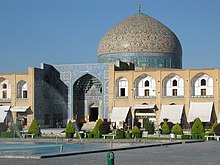
Mosques had been built in Iraq and North Africa by the end of the 7th century, as Islam spread outside the Arabian Peninsula with early caliphates. The Imam Husayn Shrine in Karbala is reportedly one of the oldest mosques in Iraq, although its present form – typical of Persian architecture – only goes back to the 11th century. The shrine, while still operating as a mosque, remains one of the holiest sites for Shia Muslims, as it honors the death of the third Shia imam, Hussein ibn Ali. The Mosque of Amr ibn al-As was reportedly the first mosque in Egypt, serving as a religious and social center for Fustat (present-day Cairo) during its prime. Like the Imam Husayn Shrine, though, nothing of its original structure remains. With the later Fatimid Caliphate, mosques throughout Egypt evolved to include schools (known as madrasas), hospitals, and tombs.


The Great Mosque of Kairouan in present-day Tunisia was reportedly the first mosque built in northwest Africa, with its present form (dating from the 9th century) serving as a model for other Islamic places of worship in the Maghreb. It was the first to incorporate a square minaret (as opposed to the more common circular minaret) and includes naves akin to a basilica. Those features can also be found in Andalusian mosques, including the Grand Mosque of Cordoba, as they tended to reflect the architecture of the Moors instead of their Visigoth predecessors. Still, some elements of Visigothic architecture, like horseshoe arches, were infused into the mosque architecture of Spain and the Maghreb.
The first mosque in East Asia was reportedly established in the 8th century in Xi'an. However, the Great Mosque of Xi'an, whose current building dates from the 18th century, does not replicate the features often associated with mosques elsewhere. Indeed, minarets were initially prohibited by the state. Following traditional Chinese architecture, the Great Mosque of Xi'an, like many other mosques in eastern China, resembles a pagoda, with a green roof instead of the yellow roof common on imperial structures in China. Mosques in western China were more likely to incorporate elements, like domes and minarets, traditionally seen in mosques elsewhere.

A similar integration of foreign and local influences could be seen on the Indonesian islands of Sumatra and Java, where mosques, including the Demak Great Mosque, were first established in the 15th century. Early Javanese mosques took design cues from Hindu, Buddhist, and Chinese architectural influences, with tall timber, multi-level roofs similar to the pagodas of Balinese Hindu temples; the ubiquitous Islamic dome did not appear in Indonesia until the 19th century. In turn, the Javanese style influenced the styles of mosques in Indonesia's Austronesian neighbors—Malaysia, Brunei, and the Philippines.

Muslim empires were instrumental in the evolution and spread of mosques. Although mosques were first established in India during the 7th century, they were not commonplace across the subcontinent until the arrival of the Mughals in the 16th and 17th centuries. Reflecting their Timurid origins, Mughal-style mosques included onion domes, pointed arches, and elaborate circular minarets, features common in the Persian and Central Asian styles. The Jama Masjid in Delhi and the Badshahi Mosque in Lahore, built in a similar manner in the mid-17th century, remain two of the largest mosques on the Indian subcontinent.
The Umayyad Caliphate was particularly instrumental in spreading Islam and establishing mosques within the Levant, as the Umayyads constructed among the most revered mosques in the region—the al-Aqsa Mosque and Dome of the Rock in Jerusalem and the Umayyad Mosque in Damascus. The designs of the Dome of the Rock and the Umayyad Mosque were influenced by Byzantine architecture, a trend that continued with the rise of the Ottoman Empire.

Several of the early mosques in the Ottoman Empire were originally churches or cathedrals from the Byzantine Empire, with the Hagia Sophia (one of those converted cathedrals) informing the architecture of mosques from after the Ottoman conquest of Constantinople. Still, the Ottomans developed their own architectural style characterized by large central rotundas (sometimes surrounded by multiple smaller domes), pencil-shaped minarets, and open facades.
Mosques from the Ottoman period are still scattered across Eastern Europe, but the most rapid growth in the number of mosques in Europe has occurred within the past century as more Muslims have migrated to the continent. Many major European cities are home to mosques, like the Grand Mosque of Paris, that incorporate domes, minarets, and other features often found with mosques in Muslim-majority countries. The first mosque in North America was founded by Albanian Americans in 1915, but the continent's oldest surviving mosque, the Mother Mosque of America, only dates back to the 1930s. As in Europe, the number of American mosques has rapidly increased in recent decades as Muslim immigrants, particularly from South Asia, have come in the United States. Greater than forty percent of mosques in the United States were constructed after 2000.
Conversion of places of worship
Main article: Conversion of non-Muslim places of worship into mosques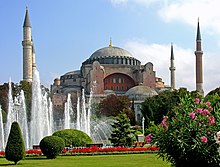
According to early Muslim historians, towns that surrendered without resistance and made treaties with the Muslims gave the Muslims permission to take their churches and synagogues. One of the earliest examples of these kinds of conversions was in Damascus, Syria, where in 705 Umayyad caliph Al-Walid I bought the church of St. John from the Christians and had it rebuilt as a mosque in exchange for building a number of new churches for the Christians in Damascus. Overall, Abd al-Malik ibn Marwan (Al-Waleed's father) is said to have transformed 10 churches in Damascus into mosques.
The process of turning churches into mosques was especially intensive in the villages where most of the inhabitants converted to Islam. The Abbasid caliph al-Ma'mun turned many churches into mosques. Ottoman Turks converted nearly all churches, monasteries, and chapels in Constantinople, including the famous Hagia Sophia, into mosques immediately after capturing the city in 1453. In some instances mosques have been established on the places of Jewish or Christian sanctuaries associated with Biblical personalities who were also recognized by Islam.
Mosques have also been converted for use by other religions, notably in southern Spain, following the conquest of the Moors in 1492. The most prominent of them is the Great Mosque of Cordoba. Outside of the Iberian Peninsula, such instances also occurred in southeastern Europe once regions were no longer under Muslim rule.
Religious functions
The masjid jāmi', a central mosque, can play a role in religious activities such as teaching the Quran and educating future imams.
Prayers
There are two holidays (Eids) in the Islamic calendar, Eid ul-Fitr and Eid al-Adha, during which there are special prayers held at mosques in the morning. These Eid prayers are supposed to be offered in large groups, and so, in the absence of an outdoor eidgah larger mosques will normally host them for their congregants as well as the congregants of smaller local mosques. Some mosques will even rent convention centers or other large public buildings to hold the large number of Muslims who attend. Mosques, especially those in countries where Muslims are the majority, will also host Eid prayers outside in courtyards, town squares or on the outskirts of town in an Eidgah.
Ramadan events
Islam's holiest month, Ramadan, is observed through many events. As Muslims must fast during the day during Ramadan, mosques will host iftar dinners after sunset and the fourth required prayer of the day, maghrib. Food is provided, at least in part, by members of the community, thereby creating nightly potluck dinners. Because of the community contribution necessary to serve iftar dinners, mosques with smaller congregations may not be able to host the iftar dinners daily. Some mosques will also hold suhoor meals before dawn to congregants attending the first required prayer of the day, fajr. As with iftar dinners, congregants usually provide the food for suhoor, although able mosques may provide food instead. Mosques will often invite poorer members of the Muslim community to share in beginning and breaking the fasts, as providing charity during Ramadan is regarded in Islam as especially honorable.

Following the last obligatory daily prayer (Isha') special, optional tarawih prayers are offered in larger mosques. During each night of prayers, which can last for up to two hours each night, usually one member of the community who has memorized the entire Quran (a Hafiz) will recite a segment of the book. Sometimes, several such people (not necessarily of the local community) take turns to do this. During the last ten days of Ramadan, larger mosques will host all-night programs to observe Laylat al-Qadr, the night Muslims believe that Muhammad first received Quranic revelations. On that night, between sunset and sunrise, mosques employ speakers to educate congregants in attendance about Islam. Mosques or the community usually provide meals periodically throughout the night

During the last ten days of Ramadan, larger mosques within the Muslim community will host Iʿtikāf, a practice in which at least one Muslim man from the community must participate. Muslims performing itikaf are required to stay within the mosque for ten consecutive days, often in worship or learning about Islam. As a result, the rest of the Muslim community is responsible for providing the participants with food, drinks, and whatever else they need during their stay.
Charity
The third of the Five Pillars of Islam states that Muslims are required to give approximately one-fortieth of their wealth to charity as zakat. Since mosques form the center of Muslim communities, they are where Muslims go to both give zakat and, if necessary, collect it. Prior to the holiday of Eid ul-Fitr, mosques also collect a special zakat that is supposed to assist in helping poor Muslims attend the prayers and celebrations associated with the holiday.
Contemporary political roles
See also: Political aspects of Islam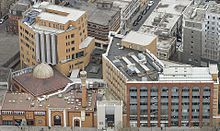
The late 20th century saw an increase in the number of mosques used for political purposes. Today, civic participation is commonly promoted in mosques in the Western world. Because of the importance in the community, mosques are used for preaching peaceful coexistence with non-believers, even in times of adversity.
Large mosques sometimes play a political role as well. In Islamic countries like Bangladesh, Pakistan, Iran, and Iraq (after 2003), political subjects are preached by imams at Friday congregations on a regular basis. In other Islamic countries, imams are usually banned from mentioning political issues.
Advocacy
Countries with a minority Muslim population are more likely than Muslim-majority countries of the Greater Middle East to use mosques as a way to promote civic participation. American mosques host voter registration and civic participation drives that promote involving Muslims, who are often first- or second-generation immigrants, in the political process. As a result of these efforts as well as attempts at mosques to keep Muslims informed about the issues facing the Muslim community, regular mosque attendants are more likely to participate in protests, sign petitions, and otherwise be involved in politics.
Nevertheless, a link between political views and mosque attendance can still be seen in other parts of the world. Following the al-Askari Mosque bombing in February 2006, imams and other Islamic leaders used mosques and Friday prayers as vehicles to call for calm and peace in the midst of widespread violence.
Social conflict
See also: Islamophobia and Israeli–Palestinian conflict
As they are considered important to the Muslim community, mosques, like other places of worship, can be at the heart of social conflicts. The Babri Mosque was the subject of such a conflict up until the early 1990s when it was demolished. Before a mutual solution could be devised, the mosque was destroyed on December 6, 1992 as the mosque was built by Babur allegedly on the site of a previous Hindu temple marking the birthplace of Rama. The controversy surrounded the mosque was directly linked to rioting in Bombay (present-day Mumbai) as well as bombings in 1993 that killed 257 people.
Bombings in February 2006 and June 2007 seriously damaged Iraq's al-Askari Mosque and exacerbated existing tensions. Other mosque bombings in Iraq, both before and after the February 2006 bombing, have been part of the conflict between the country's groups of Muslims. However, mosque bombings have not been exclusive to Iraq; in June 2005, a suicide bomber killed at least 19 people at an Afghan Shia mosque near Jade Maivand. In April 2006, two explosions occurred at India's Jama Masjid.
Following the September 11 attacks, several American mosques were targeted in attacks ranging from simple vandalism to arson. Furthermore, the Jewish Defense League was suspected of plotting to bomb the King Fahd Mosque in Culver City, California. Similar attacks occurred throughout the United Kingdom following the 7 July 2005 London bombings. Outside the Western world, in June 2001, the Hassan Bek Mosque was the target of vandalism and attacks by hundreds of Israelis after a suicide bomber killed 19 people in a night club in Tel Aviv.
Saudi influence

Although the Saudi involvement in mosques around the world can be traced back to the 1960s, it was not until later in the 20th century that the government of Saudi Arabia became a large influence in foreign mosques. Beginning in the 1980s, the Saudi Arabian government began to finance the construction of mosques in countries around the world. An estimated US$45 billion has been spent by the Saudi Arabian government financing mosques and Islamic schools in foreign countries. Ain al-Yaqeen, a Saudi newspaper, reported in 2002 that Saudi funds may have contributed to building as many as 1,500 mosques and 2,000 other Islamic centers.
Saudi citizens have also contributed significantly to mosques in the Islamic world, especially in countries where they see Muslims as poor and oppressed. Following the fall of the Soviet Union, in 1992, mosques in war-torn Afghanistan saw many contributions from Saudi citizens. The King Fahd Mosque in Culver City, California and the Islamic Cultural Center of Italy in Rome represent two of Saudi Arabia's largest investments in foreign mosques as former Saudi king Fahd bin Abdul Aziz al-Saud contributed US$8 million and US$50 million to the two mosques, respectively.
Architecture
Styles
Further information: Islamic architecture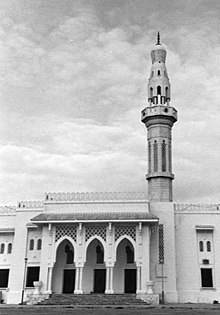
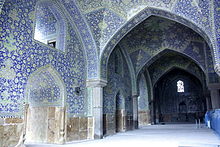
Arab-plan or hypostyle mosques are the earliest type of mosques, pioneered under the Umayyad Dynasty. These mosques have square or rectangular plans with an enclosed courtyard and covered prayer hall. Historically, in the warm Middle Eastern and Mediterranean climates, the courtyard served to accommodate the large number of worshippers during Friday prayers. Most early hypostyle mosques had flat roofs on prayer halls, which required the use of numerous columns and supports. One of the most notable hypostyle mosques is the Great Mosque of Cordoba in Spain, the building being supported by over 850 columns. Frequently, hypostyle mosques have outer arcades so that visitors can enjoy the shade. Arab-plan mosques were constructed mostly under the Umayyad and Abbasid dynasties; subsequently, however, the simplicity of the Arab plan limited the opportunities for further development, the mosques consequently losing popularity.
The first separate brand within mosque designs started appearing in Persia (Iran). The Persians had inherited a rich architectural legacy from the earlier Persian dynasties, and they started incorporating elements from earlier Parthian and Sassanid palace-designs into their mosques, influenced by buildings such as the Palace of Ardashir and the Sarvestan Palace. Thus, Islamic architecture started witnessing the introduction of such structures as domes and large, arched entrances, referred to as iwans. During Seljuq rule, as Islamic mysticism was on the rise, the four-iwan arrangement took form. The four-iwan format, finalized by the Seljuqs, and later inherited by the Safavids, firmly established the courtyard facade of such mosques, with the towering gateways at every side, as more important than the actual buildings themselves, and they typically took the form of a square-shaped, central courtyard with large entrances at each side, giving the impression of being gateways to the spiritual world. Soon, a distinctly Persian style of mosques started appearing that would significantly influence the designs of later Timurid, and also Mughal, mosque designs.

The Ottomans introduced central dome mosques in the 15th century. These mosques have a large dome centered over the prayer hall. In addition to having a large central dome, a common feature is smaller domes that exist off-center over the prayer hall or throughout the rest of the mosque, where prayer is not performed. This style was heavily influenced by Byzantine architecture with its use of large central domes. Hajja Soad's mosque took a pyramid shape which is a creative style in Islamic architecture.
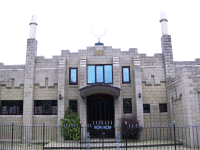
The Faisal Mosque in Islamabad, Pakistan in a relatively unusual design fuses contemporary lines with the more traditional look of an Arab Bedouin's tent, with its large triangular prayer hall and four minarets. However, unlike traditional mosque design, it lacks a dome. The mosque's architecture is a departure from the long history of South Asian Islamic architecture. It is one of the most outstanding and modern Islamic architecture examples in the world.
Mosques built in Southeast Asia often represent the Indonesian-Javanese style architecture, which are different from the ones found throughout the Greater Middle East. The ones found in Europe and North America appear to have various styles but most are built on Western artchitectural designs, some are former churches or other buildings that were used by non-Muslims. In Africa, most mosques are old but the new ones are built to give it a look of the Greater Middle East. This can be seen in the Abuja National Mosque in Nigeria and others.
Minarets
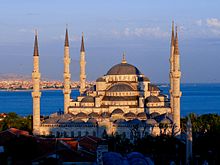
A common feature in mosques is the minaret, the tall, slender tower that usually is situated at one of the corners of the mosque structure. The top of the minaret is always the highest point in mosques that have one, and often the highest point in the immediate area. The tallest minaret in the world is located at the Hassan II Mosque in Casablanca, Morocco. It has a height of 210 metres (689 ft) and completed in 1993, it was designed by Michel Pinseau. The first mosques had no minarets, and even nowadays the most conservative Islamic movements, like Wahhabis, avoid building minarets, seeing them as ostentatious and hazardous in case of collapse. The first minaret was constructed in 665 in Basra during the reign of the Umayyad caliph Muawiyah I. Muawiyah encouraged the construction of minarets, as they were supposed to bring mosques on par with Christian churches with their bell towers. Consequently, mosque architects borrowed the shape of the bell tower for their minarets, which were used for essentially the same purpose—calling the faithful to prayer. The oldest standing minaret in the world is the minaret of the Great Mosque of Kairouan in Tunisia, built between the 8th and the 9th century, it is a massive square tower consisting of three superimposed tiers of gradual size and decor.

Before the five required daily prayers, a muezzin calls the worshippers to prayer from the minaret. In many countries like Singapore where Muslims are not the majority, mosques are prohibited from loudly broadcasting the call to prayer (adhan), although it is supposed to be said loudly to the surrounding community. The adhan is required before every prayer. However, nearly every mosque assigns a muezzin for each prayer to say the adhan as it is a recommended practice or sunnah of the Islamic prophet Muhammad. At mosques that do not have minarets, the adhan is called instead from inside the mosque or somewhere else on the ground. The iqama, which is similar to the adhan and said immediately before the start of prayer, is usually not said from the minaret even if a mosque has one.
Mihrab

A mihrab is a semicircular niche in the wall of a mosque that indicates the qibla. That is, the direction of the Kaaba in Mecca and hence the direction that Muslims should face when praying. The wall in which a mihrab appears is thus the "qibla wall."
Mihrabs should not be confused with the minbar, which is the raised platform from which an Imam (leader of prayer) addresses the congregation.
Domes

The domes, often placed directly above the main prayer hall, may signify the vaults of heaven and the sky. As time progressed, domes grew, from occupying a small part of the roof near the mihrab to encompassing the whole roof above the prayer hall. Although domes normally took on the shape of a hemisphere, the Mughals in India popularized onion-shaped domes in South Asia. Some mosques have multiple, often smaller, domes in addition to the main large dome that resides at the center.
Prayer hall
The prayer hall, also known as the musallah, rarely has furniture; chairs and pews are generally absent from the prayer hall so as to allow as many worshipers as possible to line the room. Some mosques have Islamic calligraphy and Quranic verses on the walls to assist worshippers in focusing on the beauty of Islam and its holiest book, the Quran, as well as for decoration.

Often, a limited part of the prayer hall is sanctified formally as a masjid in the sharia sense (although the term masjid is also used for the larger mosque complex as well). Once designated, there are onerous limitations on the use of this formally designated masjid, and it may not be used for any purpose other than worship; restrictions that do not necessarily apply to the rest of the prayer area, and to the rest of the mosque complex (although such uses may be restricted by the conditions of the waqf that owns the mosque).
In many mosques, especially the early congregational mosques, the prayer hall is in the hypostyle form (the roof held up by a multitude of columns). One of the finest examples of the hypostyle-plan mosques is the Great Mosque of Kairouan (also known as the Mosque of Uqba) in Tunisia.
Usually opposite the entrance to the prayer hall is the qiblah wall, the visually emphasized area inside the prayer hall. The qiblah wall should, in a properly oriented mosque, be set perpendicular to a line leading to Mecca, the location of the Kaaba. Congregants pray in rows parallel to the qiblah wall and thus arrange themselves so they face Mecca. In the qiblah wall, usually at its center, is the mihrab, a niche or depression indicating the direction of Mecca. Usually the mihrab is not occupied by furniture either. Sometimes, especially during Friday prayers, a raised minbar or pulpit is located to the side of the mihrab for a khatib or some other speaker to offer a sermon (khutbah). The mihrab serves as the location where the imam leads the five daily prayers on a regular basis.
Ablution facilities

As ritual purification precedes all prayers, mosques often have ablution fountains or other facilities for washing in their entryways or courtyards. However, worshippers at much smaller mosques often have to use restrooms to perform their ablutions. In traditional mosques, this function is often elaborated into a freestanding building in the center of a courtyard. This desire for cleanliness extends to the prayer halls where shoes are disallowed to be worn anywhere other than the cloakroom. Thus, foyers with shelves to put shoes and racks to hold coats are commonplace among mosques.
Contemporary features
Modern mosques have a variety of amenities available to their congregants. As mosques are supposed to appeal to the community, they may also have additional facilities, from health clinics to libraries to gymnasiums, to serve the community.
Makeshift and temporary structures for Islamic worship
A temporary place set aside for Islamic worship is called a musalla (Jama'at Khana in South Asia). A musallah is often not part of a permanent endowment (waqf), or it is otherwise not intended to become a permanent legal masjid (as defined in the Sharia). Often musallas are used while a community looks for a piece of land for a permanent masjid, or the establishment of a masjid is not practical at the time. They could be located in rented apartments, industrial units or store fronts.
Rules and etiquette
Mosques, in accordance with Islamic practices, institute a number of rules intended to keep Muslims focused on worshipping God. While there are several rules, such as those regarding not allowing shoes in the prayer hall, that are universal, there are many other rules that are dealt with and enforced in a variety of ways from mosque to mosque.
Prayer leader

Appointment of a prayer leader is considered desirable, but not always obligatory. The permanent prayer leader (imam) must be a free honest individual and is authoritative in religious matters. In mosques constructed and maintained by the government, the prayer leader is appointed by the ruler; in private mosques, however, appointment is made by members of the congregation through majority voting. According to the Hanafi school of Islamic jurisprudence, the individual who built the mosque has a stronger claim to the title of imam, but this view is not shared by the other schools.
Leadership at prayer falls into three categories, depending on the type of prayer: five daily prayers, Friday prayer, or optional prayers. According to the Hanafi and Maliki school of Islamic jurisprudence, appointment of a prayer leader for Friday service is mandatory because otherwise the prayer is invalid. The Shafi'i and Hanbali schools, however, argue that the appointment is not necessary and the prayer is valid as long as it is performed in a congregation. A slave may lead a Friday prayer, but Muslim authorities disagree over whether the job can be done by a minor. An imam appointed to lead Friday prayers may also lead at the five daily prayers; Muslim scholars agree to the leader appointed for five daily services may lead the Friday service as well.
All Muslim authorities hold the consensus opinion that only men may lead prayer for men. Nevertheless, women prayer leaders are allowed to lead prayer in front of all-female congregations.
Cleanliness
See also: Ritual purity in Islam
All mosques have rules regarding cleanliness, as it is an essential part of the worshippers' experience. Muslims before prayer are required to cleanse themselves in an ablution process known as wudu. However, even to those who enter the prayer hall of a mosque without the intention of praying, there are still rules that apply. Shoes must not be worn inside the carpeted prayer hall. Some mosques will also extend that rule to include other parts of the facility even if those other locations are not devoted to prayer. Congregants and visitors to mosques are supposed to be clean themselves. It is also undesirable to come to the mosque after eating something that smells, such as garlic.
Dress
Islam requires that its adherents wear clothes that portray modesty. Men are supposed to come to the mosque wearing loose and clean clothes that do not reveal the shape of the body. Likewise, it is recommended that women at a mosque wear loose clothing that covers to the wrists and ankles, and cover their heads with a hijab or other covering. Many Muslims, regardless of their ethnic background, wear Middle Eastern clothing associated with Arabic Islam to special occasions and prayers at mosques.
Concentration

As mosques are places of worship, those within the mosque are required to remain respectful to those in prayer. Loud talking within the mosque, as well as discussion of topics deemed disrespectful, is forbidden in areas where people are praying. In addition, it is disrespectful to walk in front of or otherwise disturb Muslims in prayer. The walls within the mosque have few items, except for possibly Islamic calligraphy, so Muslims in prayer are not distracted. Muslims are also discouraged from wearing clothing with distracting images and symbols so as not to divert the attention of those standing behind them during prayer. In many mosques, even the carpeted prayer area has no designs, its plainness helping worshippers to focus.
Gender separation
Further information: Gender segregation and Islam
There is nothing written in the Qurʼan about the issue of space in mosques and gender separation. However, traditional rules have segregated women and men. By traditional rules, women are most often told to occupy the rows behind the men. In part, this was a practical matter as the traditional posture for prayer – kneeling on the floor, head to the ground – made mixed-gender prayer uncomfortably revealing for many women and distracting for some men. Traditionalists try to argue that Muhammad preferred women to pray at home rather than at a mosque, and they cite a hadith in which Muhammad supposedly said: "The best mosques for women are the inner parts of their houses," although women were active participants in the mosque started by Muhammad. Muhammad told Muslims not to forbid women from entering mosques. They are allowed to go in. The second Sunni caliph ʻUmar at one time prohibited women from attending mosques especially at night because he feared they may be sexually harassed or assaulted by men, so he required them to pray at home. Sometimes a special part of the mosque was railed off for women; for example, the governor of Mecca in 870 had ropes tied between the columns to make a separate place for women.

Many mosques today will put the women behind a barrier or partition or in another room. Mosques in South and Southeast Asia put men and women in separate rooms, as the divisions were built into them centuries ago. In nearly two-thirds of American mosques, women pray behind partitions or in separate areas, not in the main prayer hall; some mosques do not admit women at all due to the lack of space and the fact that some prayers, such as the Friday Jumuʻah, are mandatory for men but optional for women. Although there are sections exclusively for women and children, the Grand Mosque in Mecca is desegregated.
Non-Muslims in mosques
Under most interpretations of sharia, non-Muslims are permitted to enter mosques provided that they respect the place and the people inside it. Prophet Muhammad once allowed a group of Christians to pray inside Al-Masjid al-Nabawi for their Sunday worship. A dissenting opinion and minority view is presented by followers of the Maliki school of Islamic jurisprudence, who argue that non-Muslims may not be allowed into mosques under any circumstances.
The Quran addresses the subject of non-Muslims, and particularly polytheists, in mosques in two verses in its ninth chapter, Sura At-Tawba. The seventeenth verse of the chapter prohibits those who join gods with Allah—polytheists—from entering mosques:
It is not for such as join gods with Allah, to visit or maintain the mosques of Allah while they witness against their own souls to infidelity. The works of such bear no fruit: In Fire shall they dwell.
— Quran, Sura 9 (At-Tawba), ayah 17
The twenty-eighth verse of the same chapter is more specific as it only considers polytheists in the Sacred Mosque, the Masjid al-Haram in Mecca:
O ye who believe! Truly the Pagans are unclean; so let them not, after this year of theirs, approach the Sacred Mosque. And if ye fear poverty, soon will Allah enrich you, if He wills, out of His bounty, for Allah is All-knowing, All-wise.
— Quran, Sura 9 (At-Tawba), ayah 28
According to Ahmad ibn Hanbal, these verses were followed to the letter at the times of Muhammad, when Jews and Christians, considered monotheists, were still allowed to the Masjid al-Haram. However, the Umayyad caliph Umar II later forbade non-Muslims from entering mosques, and his ruling remains in practice in present-day Saudi Arabia. Today, the decision on whether non-Muslims should be allowed to enter mosques varies. With few exceptions, mosques in the Arabian Peninsula as well as Morocco do not allow entry to non-Muslims. For example, the Hassan II Mosque in Casablanca is one of only two mosques in Morocco currently open to non-Muslims.

However, there are also many other places in the West as well as the Islamic world where non-Muslims are welcome to enter mosques. Most mosques in the United States, for example, report receiving non-Muslim visitors every month. Many mosques throughout the United States welcome non-Muslims as a sign of openness to the rest of the community as well as to encourage conversions to Islam.
In modern-day Saudi Arabia, the Grand Mosque and all of Mecca are open only to Muslims. Likewise, the Al-Masjid al-Nabawi and the city of Medina that surrounds it are also off-limits to those who do not practice Islam. For mosques in other areas, it has most commonly been taken that non-Muslims may only enter mosques if granted permission to do so by Muslims and if they have a legitimate reason. All entrants regardless of religious affiliation are expected to respect the rules and decorum for mosques.

In modern Turkey, non-Muslim tourists are allowed to enter any mosque, but there are some strict rules. Visiting a mosque is allowed only between prayers; visitors are required to wear long trousers and not to wear shoes, women must cover their heads; visitors are not allowed to interrupt praying Muslims, especially by taking photos of them; no loud talk is allowed; and no references to other religions are allowed (no crosses on necklaces, no cross gestures, etc.) Similar rules apply to mosques in Malaysia, where larger mosques that are also tourist attractions (such as the Masjid Negara) provide robes and headscarves for visitors who are deemed inappropriately attired.
In certain times and places, non-Muslims were expected to behave a certain way in the vicinity of a mosque: in some Moroccan cities, Jews were required to remove their shoes when passing by a mosque; in 18th-century Egypt, Jews and Christians had to dismount before several mosques in veneration of their sanctity.
See also
- Holiest sites in Islam
- Imam khatib (Sunni Islam)
- Imamah (Shi'a doctrine)
- List of the historical structures in the Isfahan province
- Lists of mosques
- Loudspeakers in mosques
- Muezzin
By size
Further information: List of large mosques Portals:Notes and references
- ^ "Fiqh of Masjid & Musalla". Qa.sunnipath.com. 2005-07-03. Archived from the original on 2011-10-19. Retrieved 2011-11-03.
{{cite web}}: Unknown parameter|deadurl=ignored (|url-status=suggested) (help) - For the word's origin from French and probable origin from Italian moscheta, see "mosque, n.". OED Online. December 2011. Oxford University Press. . For the derivation of moscheta from Arabic sajada see "mesquita, n.". OED Online. December 2011. Oxford University Press. . For the probable origin of "sajada" from Aramaic, and the meanings of sajada and masjid in Arabic, see "masjid, n.". OED Online. December 2011. Oxford University Press. . For the inclusion of Spanish mesquita, possible derivation from Nabataean masgdhā́, and the Aramaic sghēdh, see Klein, E., A Comprehensive Etymological Dictionary of the English Language (Elsevier Publishing, 1966), p. 1007.
- Kuban 1974, p. 1 harvnb error: multiple targets (2×): CITEREFKuban1974 (help)
- Dumper & Stanley 2007, p. 241
- Tajuddin 1998, p. 135
- ^ Chiu 2010, pp. 67–8 harvnb error: no target: CITEREFChiu2010 (help)
- Cosman & Jones 2008, p. 610
- Bellows 2008, p. 249
- Netton 1996, p. 149
- Budge 2001, pp. 123–8
- "Minaret of the Great Mosque of Kairouan". The Qantara Project. 2008. Retrieved 5 October 2013.
- ^ Elleh 2002, pp. 114–5
- Ruggles 2002, p. 38
- ^ Cowen 1985, pp. 30–5
- ^ Ahmed 2002, p. 109
- ^ Bloom & Blair 2009, p. 439
- Bloom & Blair 2009, p. 281
- Bloom & Blair 2009, p. 182
- Bloom & Blair 2009, p. 187
- Asher 1992, p. 202 harvnb error: multiple targets (2×): CITEREFAsher1992 (help)
- Kuban 1985, p. 27
- Flood 2001, pp. 101–3
- Nielsen et al. 2011, p. 603
- ^ Bloom & Blair 2009, p. 193
- Essa & Ali 2010, pp. 230–1
- Essa & Ali 2010, pp. 231–2
- Nimer 2002, pp. 39–40
- Grossman, Cathy Lynn (29 February 2012). "Number of U.S. mosques up 74% since 2000". USA Today. Retrieved 6 October 2013.
- M. Th. Houtsma (1993). E.J. Brill's First Encyclopedia of Islam, 1913-1936. BRILL. p. 21. ISBN 978-90-04-09791-9. Retrieved 21 February 2013.
- ^ Hillenbrand, R. "Masdjid. I. In the central Islamic lands". In P. J. Bearman, Th. Bianquis, C.E. Bosworth, E. van Donzel and W. P. Heinrichs (ed.). Encyclopaedia of Islam Online. Brill Academic Publishers. ISSN 1573-3912.
{{cite encyclopedia}}: CS1 maint: multiple names: editors list (link) - Wagner, William (2004) . How Islam Plans to Change the World. Kregel Publications. p. 99. ISBN 978-0-8254-3965-0.
When the Moors were driven out of Spain in 1492, most of the mosques were converted into churches
{{cite book}}:|access-date=requires|url=(help) - "'Id Prayers (Salatul 'Idain)". Compendium of Muslim Texts. University of Southern California. Retrieved April 8, 2006.
- Performance of Eid Salah in Eidgah (Open Field)
- "Charity". Compendium of Muslim Texts. University of Southern California. Retrieved April 17, 2006.
- ^ Maqsood, Ruqaiyyah Waris (April 22, 2003). Teach Yourself Islam (2nd ed.). Chicago: McGraw-Hill. pp. 57–8, 72–5, 112–120. ISBN 978-0-07-141963-5.
- Matthew Clarke (1 January 2011). Development and Religion: Theology and Practice. Edward Elgar Publishing. p. 156. ISBN 978-0-85793-073-6. Retrieved 21 February 2013.
- Eade, John (1996). "Nationalism, Community, and the Islamization of Space in London". In Metcalf, Barbara Daly (ed.). Making Muslim Space in North America and Europe. Berkeley: University of California Press. ISBN 0520204042. Retrieved 19 April 2015.
As one of the few mosques in Britain permitted to broadcast calls to prayer (azan), the mosque soon found itself at the center of a public debate about "noise pollution" when local non-Muslim residents began to protest.
- "What Muslims Hear at Friday Prayers". Der Spiegel. April 19, 2006. Retrieved October 31, 2010.
- ^ Jamal, Amany. "The Role of Mosques in the Civic and Political Incorporation of Muslim American". Teachers' College – Columbia University. Retrieved April 22, 2006.
- Swanbrow, Diane (June 23, 2005). "Study: Islam devotion not linked to terror". The University Record Online. Retrieved February 24, 2007.
- "Friday prayer plea for Iraq calm". BBC. February 24, 2006. Retrieved April 23, 2006.
- Romey, Kristen M. (July–August 2004). "Flashpoint Ayodhya". Archaeology.
- John Rollins (November 2010). International Terrorism and Transnational Crime: Security Threats, U. S. Policy, and Considerations for Congress. DIANE Publishing. p. 15. ISBN 978-1-4379-2756-6. Retrieved 21 February 2013.
- Aizenman, N.C. (June 2, 2006). "Suicide Bomber Kills 20 in Afghan Mosque". The Washington Post. p. A16. Retrieved April 23, 2006.
- Mahendra Gaur (1 June 2006). Indian Affairs Annual 2006. Gyan Publishing House. p. 146. ISBN 978-81-7835-529-0. Retrieved 21 February 2013.
- Pratiyogita Darpan (February 2009). Pratiyogita Darpan. Pratiyogita Darpan. p. 1509. Retrieved 21 February 2013.
- "IPA NY Voices That Must Be Heard". Indypressny.org. Archived from the original on October 11, 2007. Retrieved November 3, 2008.
{{cite web}}: Unknown parameter|deadurl=ignored (|url-status=suggested) (help) - "JDL Chairman, Follower Accused of Plotting to Bomb Mosque, Congressman". Associated Press via FOX News. December 13, 2001. Retrieved April 23, 2006.
- "Arafat orders immediate ceasefire". BBC. June 3, 2001. Retrieved April 23, 2006.
- Harris, John (April 22, 2006). "Paranoia, poverty and wild rumours – a journey through BNP country". London: The Guardian. Retrieved May 28, 2006.
- Carlile, Jennifer (May 25, 2006). "Italians fear mosque plans". MSNBC. Retrieved May 28, 2006.
- ^ Ottoway, David B. (August 19, 2004). "U.S. Eyes Money Trails of Saudi-Backed Charities". The Washington Post. p. A1. Retrieved February 24, 2007.
- Kaplan, David E. (December 15, 2003). "The Saudi Connection". U.S. News and World Report. Retrieved April 17, 2006.
- "Islamic Center in Rome, Italy". King Fahd bin Abdul Aziz. Retrieved April 17, 2006.
- ^ "Religious Architecture and Islamic Cultures". Massachusetts Institute of Technology. Retrieved April 9, 2006.
- ^ "THE ROYAL MOSQUE (MASJED-e-EMAM) in Isfahan, Iran". Ne.jp. Retrieved 2011-11-03.
- Stephen P. Blake (1999). Half the world: the social architecture of Safavid Isfahan, 1590-1722. Mazda Pub. pp. 143–144. ISBN 978-1-56859-087-5. Retrieved 21 February 2013.
- "Vocabulary of Islamic Architecture". Massachusetts Institute of Technology. Archived from the original on September 18, 2006. Retrieved April 9, 2006.
{{cite web}}: Unknown parameter|deadurl=ignored (|url-status=suggested) (help) - Walters, Brian (May 17, 2004). "The Prophet's People". Call to Prayer: My Travels in Spain, and Morocco. Virtualbookworm Publishing. p. 14. ISBN 978-1-58939-592-3.
Its 210-meter minaret is the tallest in the world
- Kingfisher Geography encyclopedia. ISBN 1-85613-582-9. Page 137
- "Hassan II Mosque, Casablanca". Sacred Destinations. Retrieved 2 October 2012.
- Hillenbrand, R. "Manara, Manar". In P.J. Bearman, Th. Bianquis, C.E. Bosworth, E. van Donzel and W.P. Heinrichs (ed.). Encyclopaedia of Islam Online. Brill Academic Publishers. ISSN 1573-3912.
{{cite encyclopedia}}: CS1 maint: multiple names: editors list (link) - Titus Burckhardt (30 March 2009). Art of Islam: Language and Meaning. World Wisdom, Inc. p. 128. ISBN 978-1-933316-65-9. Retrieved 21 February 2013.
- Linda Kay Davidson; David Martin Gitlitz (1 November 2002). Pilgrimage: From the Ganges to Graceland : An Encyclopedia. ABC-CLIO. p. 302. ISBN 978-1-57607-004-8. Retrieved 21 February 2013.
- "Great Mosque of Kairouan". Muslim Heritage.com. 2003-04-24. Retrieved 2011-11-03.
- Mainzer, Klaus (June 1, 1996). "Art and Architecture". Symmetries of Nature: A Handbook for Philosophy of Nature and Science. Berlin: Walter de Gruyter. p. 124. ISBN 978-3-11-012990-8.
the dome arching over the believers like the spherical dome of the sky
- Asher, Catherine B. (September 24, 1992). "Aurangzeb and the Islamization of the Mughal style". Architecture of Mughal India. Cambridge University Press. p. 256. ISBN 978-0-521-26728-1.
- ^ "Mosque FAQ". The University of Tulsa. Archived from the original on March 30, 2007. Retrieved April 9, 2006.
{{cite web}}: Unknown parameter|deadurl=ignored (|url-status=suggested) (help) - Fred S. Kleiner (2010). Gardner's Art Through the Ages: The Western Perspective. Cengage Learning. p. 265. ISBN 978-0-495-57355-5. Retrieved 21 February 2013.
- Fred S. Kleiner (2010). Gardner's Art Through the Ages: The Western Perspective. Cengage Learning. p. 267. ISBN 978-0-495-57355-5. Retrieved 21 February 2013.
- Bierman, Irene A. (December 16, 1998). Writing Signs: Fatimid Public Text. University of California Press. p. 150. ISBN 978-0-520-20802-5.
- "Terms 1: Mosque". University of Tokyo Institute of Oriental Culture. Retrieved April 9, 2006.
- ^ Abu al-Hasankok Ibn Muhammad Ibn Habib, Al-Mawardi (2000). The Ordinances of Government (Al-Ahkam al-Sultaniyya w'al-Wilayat al-Diniyya). Lebanon: Garnet Publishing. p. 184. ISBN 978-1-85964-140-8.
- Karin van Nieuwkerk, "Women Embracing Islam". University of Texas Press. 2006. p. 63. ISBN 9780292773769.
- "Chapter 16. The Description of the Prayer". SunniPath Library. SunniPath. Archived from the original on November 28, 2006. Retrieved July 12, 2006.
{{cite web}}: Unknown parameter|deadurl=ignored (|url-status=suggested) (help) - Connecting Cultures, Inc. "Building Cultural Competency: Understanding Islam, Muslims, and Arab Culture" (Doc). Connecting Cultures, Inc.: 15. Retrieved July 12, 2006.
{{cite journal}}: Cite journal requires|journal=(help) - John Renard (1996), Seven Doors to Islam: Spirituality and the Religious Life of Muslims. University of California Press. p. 47
- Doi, Abdur Rahman I. "Women in Society". Compendium of Muslim Texts. University of Southern California. Retrieved April 15, 2006.
- Rezk, Rawya (January 26, 2006). "Muslim Women Seek More Equitable Role in Mosques". The Columbia Journalist. Retrieved April 9, 2006.
- http://www.onislam.net/english/reading-islam/about-muhammad/461130-prophetic-respect-for-christians-and-jews.html
- Quran 9:17
- Quran 9:28
- "Morocco travel". CNN. Archived from the original on October 12, 2007. Retrieved September 22, 2006.
{{cite web}}: Unknown parameter|deadurl=ignored (|url-status=suggested) (help) - Bagby, Ihsan; Perl, Paul M.; and Froehle, Bryan T. (2001). "The Masjid in America: A National Portrait" (PDF). Council on American-Islamic Relations. Retrieved April 17, 2006.
{{cite journal}}: Cite journal requires|journal=(help)CS1 maint: multiple names: authors list (link) - Takim, Liyakatali (July 2004). "From Conversion to Conversation: Interfaith Dialogue in Post 9–11 America" (PDF). The Muslim World. 94 (3): 343–355. doi:10.1111/j.1478-1913.2004.00058.x. Retrieved June 16, 2006. Liyakatali Takim is a professor at McMaster University
- "Laptop link-up: A day at the mosque". BBC. December 5, 2005. Retrieved June 16, 2006.
- Goring, Rosemary (May 1, 1997). Dictionary of Beliefs & Religions. Wordsworth Editions. ISBN 978-1-85326-354-5.
- Turner, Peter; Taylor, Chris; Finlay, Hugh (1996). Malaysia, Singapore & Brunei (6 ed.). Hawthorn, Vic.: Lonely Planet. ISBN 978-0-86442-393-1.
- Stillman, Norman (1979). The Jews of Arab Lands: A History and Source Book. Philadelphia: Jewish Publication Society of America. p. 83. ISBN 978-0-8276-0116-1.
- Bat Ye'or (2002). Islam and Dhimmitude. Where Civilizations Collide. Madison/Teaneck, NJ: Fairleigh Dickinson University Press/Associated University Presses. p. 98. ISBN 978-0-8386-3943-6.
Bibliography
- Ahmed, Akbar S. (2002). Discovering Islam: Making Sense of Muslim History and Society. Abingdon, Eng.: Psychology Press. ISBN 9780415285254.
{{cite book}}: Invalid|ref=harv(help) - Asher, Catherine B. (1992). Architecture of Mughal India. The New Cambridge History of India. Cambridge, Eng.: Cambridge University Press. ISBN 9780521267281.
{{cite book}}: Invalid|ref=harv(help) - Bearman, P.J.; Bianquis, Th.; Bosworth, C.E.; van Donzel, E.; Heinrichs, W.P. (eds.). Encyclopaedia of Islam Online. Brill Academic Publishers. ISSN 1573-3912.
{{cite encyclopedia}}: Invalid|ref=harv(help); Missing or empty|title=(help) - Bellows, Keith, ed. (2008). Sacred Places of a Lifetime: 500 of the World's Most Peaceful and Powerful Destinations. Washington, D.C.: National Geographic Books. ISBN 9781426203367.
{{cite book}}: Invalid|ref=harv(help) - Bloom, Jonathan M.; Blair, Sheila, eds. (2009). The Grove Encyclopedia of Islamic Art and Architecture. Oxford, Eng.: Oxford University Press. ISBN 9780195309911.
{{cite book}}: Invalid|ref=harv(help) - Budge, E. A. Wallis (2001). Budge's Egypt: A Classic 19th-Century Travel Guide. Toronto: Courier Dover Publications. ISBN 9780486149530.
{{cite book}}: Invalid|ref=harv(help) - Chiu, Y. C. An Introduction to the History of Project Management: From the Earliest Times to A.D. 1900, Part 1900. Delft, the Netherlands: Eburon Uitgeverij B.V. ISBN 9789059724372.
{{cite book}}: Invalid|ref=harv(help) - Cosman, Madeleine Pelner; Jones, Linda Gale (2008). Handbook to Life in the Medieval World. New York: Infobase Publishing. ISBN 9781438109077.
{{cite book}}: Invalid|ref=harv(help) - Cowen, Jill S. (July–August 1985). "Muslims in China". Saudi Aramco World. 36 (4).
{{cite journal}}: Invalid|ref=harv(help) - Dumper, Michael; Stanley, Bruce E., eds. (2007). Cities of the Middle East and North Africa: A Historical Encyclopedia. Santa Barbara, Calif.: ABC-CLIO. ISBN 978-1-57607-919-5.
{{cite book}}: Invalid|ref=harv(help) - Elleh, Nnamdi (2002). Architecture and Power in Africa. Westport, Ct.: Greenwood Publishing Group. ISBN 9780275976798.
{{cite book}}: Invalid|ref=harv(help) - Essa, Ahmed; Ali, Othman (2010). Title Studies in Islamic Civilization: The Muslim Contribution to the Renaissance. Herndon, Va.: The International Institute of Islamic Thought. ISBN 9781565643505.
- Flood, Finbarr Barry (2001). The Great Mosque of Damascus: Studies on the Makings of an Ummayyad Visual Culture. Islamic History and Civilization. Leiden, the Netherlands: BRILL. ISBN 9789004116382.
{{cite book}}: Invalid|ref=harv(help) - Goldschmidt, Jr., Arthur; Davidson, Lawrence (2005). A Concise History of the Middle East (8th ed.). Westview Press. ISBN 978-0-8133-4275-7.
{{cite book}}: Invalid|ref=harv(help) - Kuban, Doğan (1974). The Mosque and Its Early Development. Iconography of Religions: Islam. Leiden, the Netherlands: E.J. Brill. ISBN 9789004038134.
{{cite book}}: Invalid|ref=harv(help) - Kuban, Doğan (1985). Muslim Religious Architecture: Development of Religious Architecture in Later Periods. Iconography of Religions: Islam. Leiden, the Netherlands: E.J. Brill. ISBN 9789004070844.
{{cite book}}: Invalid|ref=harv(help) - Netton, Ian Richard (1996). Seek Knowledge: Thought and Travel in the House of Islam (annotated ed.). Abingdon, Eng.: Psychology Press. ISBN 9780700703401.
{{cite book}}: Invalid|ref=harv(help) - Nielsen, Jørgen Schøler; Akgönül, Samim; Alibašić, Ahmet; Goddard, Hugh; Maréchal, Brigitte, eds. (2011). Yearbook of Muslims in Europe. Vol. 3. Leiden, the Netherlands: BRILL. ISBN 9789004205161.
{{cite book}}: Invalid|ref=harv(help) - Nimer, Mohamed (2002). The North American Muslim Resource Guide: Muslim Community Life in the United States and Canada. New York: Taylor & Francis. ISBN 9780415937283.
{{cite book}}: Invalid|ref=harv(help) - Ruggles, D. Fairchild (2002). Gardens, Landscape, and Vision in the Palaces of Islamic Spain. University Park, Penn.: Penn State Press. ISBN 9780271042725.
{{cite book}}: Invalid|ref=harv(help) - Tajuddin, Mohamed (1998). The Mosque as a Community Development Centre: Programme and Architectural Design Guidelines for Contemporary Muslim Societies. Kuala Lumpur: Penerbit UTM. ISBN 9789835201318.
{{cite book}}: Invalid|ref=harv(help)
Further reading
- Arberry, A. J. (1996). The Koran Interpreted: A Translation (1st ed.). Touchstone. ISBN 978-0-684-82507-6.
- Campanini, Massimo, Mosque, in Muhammad in History, Thought, and Culture: An Encyclopedia of the Prophet of God (2 vols.), Edited by C. Fitzpatrick and A. Walker, Santa Barbara, ABC-CLIO, 2014. ISBN 1610691776
- Hawting, Gerald R. (2000). The First Dynasty of Islam: The Umayyard Caliphate AD 661–750. Routledge. ISBN 978-0-415-24072-7.
- Khan, Muhammad Muhsin; Al-Hilali Khan; Muhammad Taqi-ud-Din (1999). Noble Quran (1st ed.). Dar-us-Salam Publications. ISBN 978-9960-740-79-9.
- Kramer (ed.), Martin (1999). The Jewish Discovery of Islam: Studies in Honor of Bernard Lewis. Syracuse University. ISBN 978-965-224-040-8.
{{cite book}}:|last=has generic name (help) - Kuban, Doğan (1974). Muslim Religious Architecture. Brill Academic Publishers. ISBN 978-90-04-03813-4.
- Lewis, Bernard (1993). Islam in History: Ideas, People, and Events in the Middle East. Open Court. ISBN 978-0-8126-9217-4.
- Lewis, Bernard (1994). Islam and the West. Oxford University Press. ISBN 978-0-19-509061-1.
- Lewis, Bernard (1996). Cultures in Conflict: Christians, Muslims, and Jews in the Age of Discovery. Oxford University Press. ISBN 978-0-19-510283-3.
- Mubarkpuri, Saifur-Rahman (2002). The Sealed Nectar: Biography of the Prophet. Dar-us-Salam Publications. ISBN 978-1-59144-071-0.
- Najeebabadi, Akbar Shah (2001). History of Islam. Dar-us-Salam Publications. ISBN 978-1-59144-034-5.
- Nigosian, S. A. (2004). Islam: Its History, Teaching, and Practices (New ed.). Indiana University Press. ISBN 978-0-253-21627-4.
- Rahman, Fazlur (1979). Islam (2nd ed.). University of Chicago Press. ISBN 978-0-226-70281-0.
- Walker, Benjamin (1998). Foundations of Islam: The Making of a World Faith. Peter Owen Publishers. ISBN 978-0-7206-1038-3.
- Kahera, Akel (2008). Deconstructing the American Mosque: Space, Gender and Aesthetics. Austin TX: University of Texas Press. ISBN 0-292-74344-0.
External links
 Texts on Wikisource:
Texts on Wikisource:
- "Mosque". Encyclopedia Americana. 1920.
- R. Phené Spiers (1911). "Mosque". Encyclopædia Britannica (11th ed.).
- "Mosque". New International Encyclopedia. 1905.
- J. H. Middleton (1883). "Mosque". Encyclopædia Britannica. Vol. 16 (9th ed.).
| People and things in the Quran | |||||||||||||||||||||||||||||||||||||||||||||||||||||||||||||||||||||||||||||
|---|---|---|---|---|---|---|---|---|---|---|---|---|---|---|---|---|---|---|---|---|---|---|---|---|---|---|---|---|---|---|---|---|---|---|---|---|---|---|---|---|---|---|---|---|---|---|---|---|---|---|---|---|---|---|---|---|---|---|---|---|---|---|---|---|---|---|---|---|---|---|---|---|---|---|---|---|---|
| |||||||||||||||||||||||||||||||||||||||||||||||||||||||||||||||||||||||||||||
| |||||||||||||||||||||||||||||||||||||||||||||||||||||||||||||||||||||||||||||
| |||||||||||||||||||||||||||||||||||||||||||||||||||||||||||||||||||||||||||||
| |||||||||||||||||||||||||||||||||||||||||||||||||||||||||||||||||||||||||||||
| Note: Names are sorted alphabetically. Standard form: Islamic name / Biblical name (title or relationship) | |||||||||||||||||||||||||||||||||||||||||||||||||||||||||||||||||||||||||||||
| Islam topics | |||||||||||||
|---|---|---|---|---|---|---|---|---|---|---|---|---|---|
| Outline of Islam | |||||||||||||
| |||||||||||||
| |||||||||||||
| |||||||||||||
| |||||||||||||
| Places of worship | |
|---|---|
| Baháʼí Faith | Baháʼí House of Worship |
| Buddhism | |
| Christianity | Church |
| Hinduism | |
| Jainism | Jain temple or Derasar or Basadi |
| Judaism | Synagogue or Shul |
| Islam | |
| Mandaeism | Mandi or Mashkhanna or Beth Manda |
| Paganism & modern paganism | |
| Shintoism | Shinto Shrine or Jinja |
| Sikhism | Gurdwara |
| Taoism | Taoist temple or Dàoguàn |
| Zoroastrianism | Fire temple or Agiary or Atashkadeh or Atashgah or Dar-e Mehr |
| Varying religions and beliefs | |
| Note: Sorted alphabetically except the last one | |
